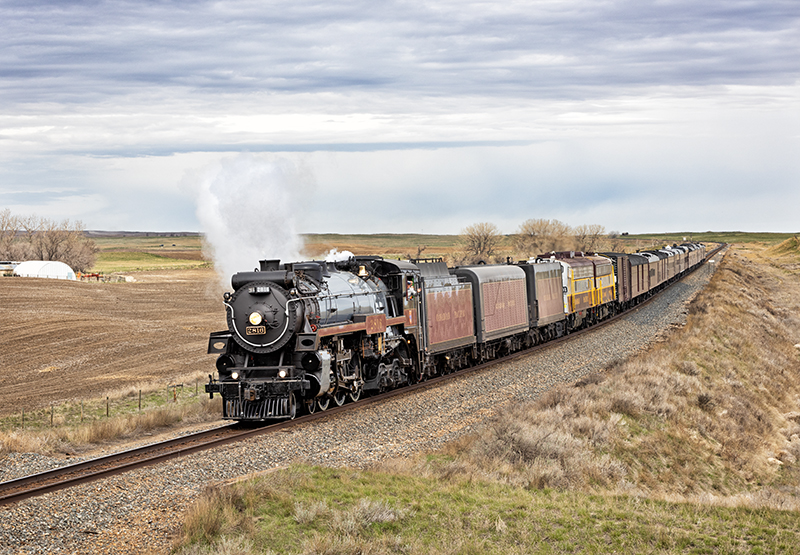By Justin Franz
After a decade out of the limelight, Canadian Pacific H1b 4-6-4 2816 put on a spectacular show during a fast-paced sprint across Alberta and Saskatchewan on April 26 and 27, kicking off what will undoubtedly go down as the steam railroading event of the year.
The CPKC Final Spike Steam Tour will take the 93-year-old Hudson on a more than 8,000-mile journey through Canada, the U.S. and Mexico over the next two months. The run will most likely go down in history as the longest steam excursion to ever feature a single locomotive.
Festivities officially kicked off on Wednesday, April 24, when thousands of people came to the CPKC campus in Calgary to see 2816 on display, not far from the shop where a small and dedicated crew has spent the last two years rebuilding the locomotive. But the real event kicked off two days later when 2816 steamed out of Calgary leading a 15-car train bound for Medicine Hat, Alberta, where the special spent its first night. Joining the locomotive are two auxiliary tenders (including one borrowed from Southern Pacific 4-8-4 4449 and two FP9 locomotives from CPKC’s heritage fleet (1401 and 4107). Also part of the consist for the first day was CP 1001, North America’s first hydrogen-powered diesel locomotive for main line use. That unit (which was built from an SD40-2F) was set out in Medicine Hat on Friday night.
After crossing the Brooks Sub on Friday and overnighting in Medicine Hat, 2816 ran east over the Maple Creek and Swift Current subdivisions on Saturday to Moose Jaw where it headlined another public event on Sunday. Besides 2816, the display events feature a mobile museum and rides aboard CPKC’s Puffer Belly mini-train.

A Maple Creek, Saskatchewan, hundreds of people waited by the tracks to see Canadian Pacific 2816, which paused in town briefly for a service stop. Photo by Justin Franz.
For locomotive 2816, the run across the Alberta and Saskatchewan prairies was familiar territory; when CP first purchased the H1a and H1b Hudsons in 1929 and 1930, they were assigned to the railroad’s premiere passenger trains on this very route. In the late 1930s, the first 20 Hudsons would later be pushed into less glamorous service by the semi-streamlined H1c, H1d and H1e locomotives, which would eventually earn the moniker “Royal Hudson” after one led King George VI’s train across Canada in 1939.
While 2816 never got such status in the steam era, she was welcomed like royalty in nearly every community she passed through on Friday and Saturday. At Maple Creek, Saskatchewan, where the train stopped for servicing on Saturday morning, hundreds of people — some waiting for hours — crowded along the main line to catch a glimpse of the locomotive and her train. Similar scenes played out at Irvine, Piapot, Gull Lake and nearly every other town the special ran through. The crowds are expected to get even bigger as the train hits larger cities, including St. Paul, Minn., Chicago and Kansas City.
The tour has been the subject of months of planning. Besides bringing auxiliary tenders with the locomotive, CPKC has stationed tank cars with pre-treated water along the route to ensure 2816 performs perfectly. Sources close to the steam crew said that so far the locomotive’s performance has been flawless. Although that might not be a surprise considering 2816’s pedigree; CP’s Hudsons regularly put on thousands of miles a month in the steam era.

Canadian Pacific 2816 sends smoke rolling across the prairies as the special approaches Gull Lake, Saskatchewan. Photo by Justin Franz.
Locomotive 2816 was built in December 1930. It was one of the last steam locomotives in regular service on the CP, working in commuter service out of Montreal into 1960. A few years later, it was sold to American preservationist F. Nelson Blount to become part of his growing Steamtown collection. After moving from Vermont to Pennsylvania, the locomotive became the property of the U.S. government when Steamtown National Historic Site was established in 1986. Because the locomotive was built and operated in Canada, it was deemed surplus by the National Park Service, despite being the only Hudson in the collection. In 1998, it was repatriated by CP and restored to operation. From 2001 until 2012, the locomotive became a roaming ambassador for the Class I railroad before it was put into storage for nearly a decade. In 2021, CP President and CEO Keith Creel announced that the locomotive would return to service if CP’s acquisition of Kansas City Southern was approved. The merger was and the two railroads were combined a year ago this month.
On Monday, the locomotive and its train were set to run to Minot, N.D., where it will be on display Tuesday. The following day it will continue toward St. Paul, Chicago, Kansas City and eventually Mexico City, where it is expected to arrive on June 4. The locomotive will return north to Calgary soon after. While a schedule for the return trip has not yet been released, it’s expected to take about a month.
For more information about the tour, visit CPKC’s website.




